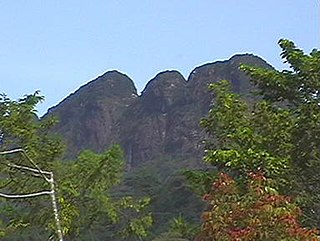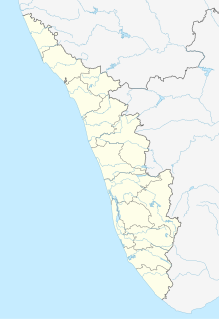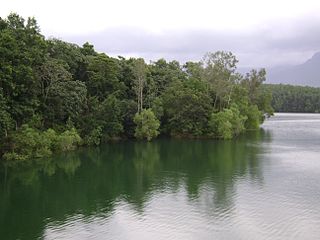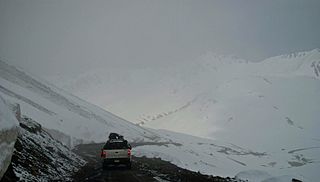
The Krishna River is the fourth-biggest river in terms of water inflows and river basin area in India, after the Ganga, Godavari and Brahmaputra. The river is almost 1,400 kilometres (870 mi) long. The river is also called Krishnaveni. It is one of the major sources of irrigation for Maharashtra, Karnataka, Telangana and Andhra Pradesh.

Kaghan Valley is an alpine-climate valley in Mansehra District of the Khyber Pakhtunkhwa Province of Pakistan. The tourists from across the country come to visit this place. The valley extends 155 kilometres (96 mi), rising from an elevation of 2,134 feet to its highest point, the Babusar Pass, at 13,690 feet. Landslides caused by the devastating 2005 Kashmir earthquake closed the Kaghan Valley road and cut off the valley from the outside. The road has been rebuilt.

Periyar National Park and Wildlife Sanctuary (PNP) is a protected area near Thekkady in the districts of Idukki, Kottayam and Pathanamthitta in Kerala, India. It is notable as an elephant reserve and a tiger reserve. The protected area covers an area of 925 km2 (357 sq mi). 305 km2 (118 sq mi) of the core zone was declared as the Periyar National Park in 1982. The park is a repository of rare, endemic and endangered flora and fauna and forms the major watershed of two important rivers of Kerala, the Periyar and the Pamba.

Bhitarkanika National Park is the core area of Bhitarkanika Wildlife Sanctuary located in the north-east region of Kendrapara district in the state of Odisha in eastern India. It spreads over 145 km2 (56 sq mi) and is surrounded by the Bhitarkanika Wildlife Sanctuary spread over 672 km2 (259 sq mi). It was designated as national park on 16 September 1998 and as a Ramsar site by UNESCO on 19 August 2002. Gahirmatha Beach and Marine Sanctuary lies to the east, and separates swamp region cover with canopy of mangroves from the Bay of Bengal.

The Deosai National Park is a high-altitude alpine plain and national park in northern Pakistan. It is located largely within Astore District in Gilgit Baltistan. Deosai Plains are situated at an average elevation of 4,114 metres above sea level.
Hadero Lake is located in Thatta District, Sindh. It is an important brackish wetland, where waterfowl occur. It was declared wildlife sanctuary for the protection of migratory and resident birds.

Baltistan Wildlife Sanctuary is a wildlife sanctuary covering an area of 415 square kilometres in the Baltistan region of northern Pakistan. Contiguous with the Astore Wildlife Sanctuary to its south and east, the Baltistan Wildlife Sanctuary lies south of the Indus River, between the villages of Rondu and Shengus, in the Skardu District. This protected area was established in 1975, for the purpose of conserving the threatened species that occupy the park, and among them there are snow leopard, brown bear, lynx, Tibetan wolf, Tibetan sand fox, markhor, bharal, and Siberian ibex.
Nara Desert Wildlife Sanctuary is located in Mirpurkhas District, Sindh, Pakistan.

Bhadra Wildlife Sanctuary is a protected area and a tiger reserve as part of Project Tiger, located 23 km (14 mi) south of Bhadravathi town and 38 km (24 mi) northwest of Chikkamagaluru town in Karnataka state, India Bhadra sanctuary has a wide range of flora and fauna and is a popular place for day outings. The 1,875 m (6,152 ft) above MSL Hebbe Giri is the highest peak in the sanctuary.

Victoria Peak within the Maya Mountains is the second highest mountain in Belize. The highest peak in the country, Doyle's Delight at a height of 1,124 metres (3,688 ft), is located 57 kilometres (35 mi) southwest of Victoria Peak. Victoria Peak is situated in the Cockscomb Basin Wildlife Sanctuary. Victoria Peak is situated in the Stann Creek District of Belize, in the Cockscomb Basin Wildlife Sanctuary, and is home to many flora and fauna common to Belize. It was pronounced a natural monument in 1998, comprising about 4,847 acres bordered by the Sittee River Forest Reserve, Cockscomb Basin Wildlife Sanctuary, and Chiquibul National Park.

The Palani Hills Wildlife Sanctuary and National Park is a proposed protected area in Dindigul District, Tamil Nadu India. The park will be an upgrade and expansion of the 736.87 km2(PRO) Palani (Kodaikanal) Wildlife Sanctuary which was to be established in 2008. The park includes about 36% of the 2,068 square kilometres (798 sq mi) in the Palani Hills. The park is located between latitude 10°7' - 10°28' N and longitude 77°16' - 77°46' E. Central location is 1.5 kilometres (0.93 mi) east northeast of Silver Cascade Waterfall and 4 kilometres (2.5 mi) E X NE of Kodaikanal Lake.

Tourism in Pakistan is a growing industry. In 2010, Lonely Planet termed Pakistan as being "...tourism's ‘next big thing’ for more years than we care to remember. [But] world media headlines [always] send things off the rails". In 2018, the British Backpacker Society ranked Pakistan as the world's top adventure travel destination, describing the country as "one of the friendliest countries on earth, with mountain scenery that is beyond anyone’s wildest imagination." The country is geographically and ethnically diverse, and has a number of historical and cultural heritage sites. According to the Travel and Tourism Competitiveness Report 2017 released by the World Economic Forum, the direct contribution of travel and tourism to Pakistan's GDP in 2015 was US$328.3 million, constituting 2.8% of the total GDP. According to the World Travel and Tourism Council, the direct contribution of travel and tourism to Pakistan's GDP in 2016 was US$7.6 billion, constituting 2.7% of the total GDP. By 2025, the government predicts tourism will contribute ₨1 trillion (US$9.5 billion) to the Pakistani economy.

The protected areas of Kerala include a wide range of biomes, extending east from the coral reefs, estuaries, salt marshes, mangroves and beaches of the Arabian Sea through the tropical moist broadleaf forests of the Malabar Coast moist forests to the North Western Ghats moist deciduous forests and South Western Ghats moist deciduous forests to South Western Ghats montane rain forests on the western border of Tamil Nadu in the Western Ghats. Most protected areas throughout its 14 districts are under the stewardship of the Kerala Forest Department and like all other protected areas of India receive support from the Ministry of Environment and Forests (India).

The Peppara Wildlife Sanctuary is a wildlife sanctuary near Thiruvananthapuram in southern Kerala, India. It consists of the catchment area of the Karamana river, which originates from Chemmunjimottai, the tallest hill within the sanctuary. The sanctuary is named after the Peppara dam, commissioned in 1983 to augment the drinking water supply to Thiruvananthapuram city and suburban areas. Considering the ecological significance of the area, it was declared a sanctuary in 1983. The terrain is undulating with elevation ranging from 100 m to 1717 m. The area of the sanctuary is 75 km2 with tropical moist evergreen forests and myristica swamps. Peppara Wildlife Sanctuary is 44 kilometres (27 mi) by car from the nearest railway station, at Thiruvananthapuram, and 49 kilometres (30 mi) from the Thiruvananthapuram airport.

The Burzil Pass is an ancient pass in northern India, and is part of the historic caravan route between Srinagar and Gilgit. The pass lies close to the Line of Control demarcating India and Pakistan, which has since closed the Burzil. The crest of the pass is wide and covered in summer with alpine grass vegetation. The Astor river originates from western slopes of the pass.

Eturnagaram Wildlife Sanctuary is a wildlife sanctuary located in Eturnagaram village in Jayashankar district in Telangana, India. It is located 250 km (160 mi) away from Hyderabad.
Gatwala Wildlife Park is a wildlife park, botanical garden and breeding center located in the town of Gatwala in Faisalabad, Punjab, Pakistan. It is situated near Khurrianwala and 140 kilometres (87 mi) away from Lahore Zoo.

Bir Shikargah Wildlife Sanctuary is situated in Panchkula district of Haryana state, India. It is spread over an area of 767.30 hectares. It also houses Vulture Conservation and Breeding Centre, Pinjore.




















